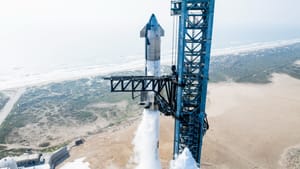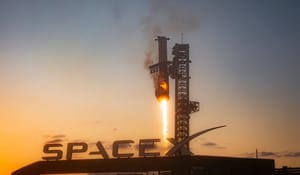
A little over two and a half months ago, SpaceX launched the third flight test of its in-development Starship-Super Heavy launch vehicle, which made it further than the previous two tests. Today, May 24th, the company announced it is targeting no earlier than June 5th for the fourth flight test, pending regulatory approval from the U.S. Federal Aviation Administration.
The fourth flight test of Starship could launch as soon as June 5, pending regulatory approvalhttps://t.co/XjreI7nQOp pic.twitter.com/2tv2s1yJ5F
— SpaceX (@SpaceX) May 24, 2024
SpaceX's no earlier than announcement on X, formerly Twitter.
The two vehicles SpaceX is expected to fly for the test are Ship 29 and Booster 11, both vehicles have completed static fire tests and a wet dress rehearsal ahead of flight. Like the previous flight tests, the only obstacle left ahead of launch is regulatory approval via a launch license from the U.S. Federal Aviation Administration.
SpaceX has also updated the schedules for both the countdown and flight plan with them now being as follows:
Countdown
| T-01:15:00 | SpaceX Flight Director conducts poll and verifies GO for propellant load |
| T-00:49:00 | Ship fuel (liquid methane) load underway |
| T-00:47:00 | Ship LOX (liquid oxygen) load underway |
| T-00:40:00 | Booster fuel (liquid methane) load underway |
| T-00:37:00 | Booster LOX (liquid oxygen) load underway |
| T-00:19:40 | Raptor begins engine chill on booster and ship |
| T-00:03:20 | Ship propellant load complete |
| T-00:02:50 | Booster propellant load complete |
| T-00:00:30 | SpaceX flight director verifies GO for launch |
| T-00:00:10 | Flame deflector activation |
| T-00:00:03 | Raptor ignition sequence begins |
| T-00:00:00 | Excitement guaranteed |
Flight Test Timeline
| T+00:00:02 | Liftoff |
| T+00:01:02 | Max Q (moment of peak mechanical stress on the rocket) |
| T+00:02:41 | Super Heavy MECO (most engines cut off) |
| T+00:02:45 | Hot-staging (Starship Raptor ignition and stage separation) |
| T+00:02:49 | Super Heavy boostback burn startup |
| T+00:03:52 | Super Heavy boostback burn shutdown |
| T+00:03:54 | Hot-stage jettison |
| T+00:06:39 | Super Heavy is transonic |
| T+00:06:43 | Super Heavy landing burn startup |
| T+00:07:04 | Super Heavy landing burn shutdown |
| T+00:08:23 | Starship engine cutoff |
| T+00:47:25 | Starship entry |
| T+01:03:11 | Starship is transonic |
| T+01:04:01 | Starship is subsonic |
| T+01:05:38 | Landing flip |
| T+01:05:43 | Landing burn |
| T+01:05:48 | An exciting landing! |
Compared to the previous flight test, propellant fuelling of liquid methane and liquid oxygen for the Ship now starts four minutes later and finishes ten seconds later, likely due to improvements with the ground service equipment. Booster propellant fuelling also starts a minute later for liquid methane and five minutes later for liquid oxygen, the end of propellant fuelling has not changed.
The flight test timeline has also seen some events removed and shifted around. The first of these is Max Q, where the launch vehicle experiences the maximum amount of stress, which is now expected ten seconds later into flight. Booster 'most engines cut off' is now one second later along with hot-staging. The 'boost back' burn is now also expected to start six seconds earlier, and end two seconds later.
SpaceX is also hoping to jettison the hot-staging ring during booster descent during the flight ahead of a landing burn. The landing burn for flight four is also expected to occur seven seconds earlier than flight three's, with the shutdown having no change.
The Ship is expected to end its ascent burn twelve seconds earlier with no events planned while it is in space, last flight the ship tested a payload bay door and had planned a Raptor relight test that did not occur. SpaceX also believes that the Ship will start reentry into Earth's atmosphere a minute and forty seconds sooner than the previous flight did.
Starship's last flight did not have the Ship survive reentry but SpaceX is planning to perform a 'flip and burn' to land if it survives the heat of atmospheric reentry, this was not included in the last three flight plans.
What happened during flight three?

SpaceX also shared an update today on what went wrong during flight three and what mitigations and preventions flight four has to prevent similar issues.
During flight three, ship 28 and Booster 10 completed a nominal ascent with all thirty-three raptors running successfully on Super Heavy, and Starship successfully lighting all six engines and hot-staging.
The first problem in flight three was during the Boosters 'boost back' burn where all thirteen engines needed started successfully before six engines shut down early. These six engines shutting down early led to a shorter 'boost back' burn but did not prevent a landing burn attempt. The landing burn was then attempted but with the six engines disabled leading to only seven being commanded to start, only two successfully started with one appearing to burn off nominally. SpaceX believes the most likely root cause of this issue was a continuous filter blockage for liquid oxygen to the engines, which led to a loss of inlet pressure in the oxygen turbopumps. Ahead of flight four, SpaceX has said they are implementing software and hardware changes in hopes of preventing this.
The other major issue faced during the last flight test was a loss of attitude control of the Ship after it began its in-space coast phase. This led to the Ship rolling along all three axes. The lack of control also had the ship reenter Earth's atmosphere off nominally and heating both the protected and unprotected sides of the vehicle. SpaceX believes the cause of this issue was clogging of the valves responsible for roll control in-space. In order to prevent a similar issue, additional roll control thrusters have been added along with upgraded hardware with resilience to the blockage.
What is Starship-Super Heavy?
Starship-Super Heavy is SpaceX's in-development fully reusable super heavy-lift launch vehicle and the largest rocket currently flying. SpaceX is currently aiming to have the launch vehicle deliver one-hundred and fifty tons to low Earth orbit while reused or two-hundred and fifty tons when expended, although there are rumors from SpaceX of an expendable payload capacity of three-hundred tons.
On the launch pad, Starship-Super Heavy is one-hundred and twenty-one meters tall and weighs 5,000,000 kilograms fully fuelled. The diameter of both vehicles is nine meters, excluding aerodynamic control surfaces.
What is Starship?

Starship is the second-stage of the Starship-Super Heavy launch vehicle and is planned to be capable of multiple missions into orbit, after a short refurbishment. The vehicle is fifty meters tall and nine meters in diameter, excluding its four aerodynamic control surfaces. Fully fuelled Starship is believed to weigh 1,300,000 kilograms with an approximate weight of 100,000 kilograms unfuelled.
The Starship second-stage is powered by three sea-level Raptor engines along with three vacuum-optimized Raptor engines. These sea-level engines are believed to generate 230 tons of thrust each with the vacuum-optimized engines generating 258 tons of thrust each for a total combined 1,500 tons of thrust for Starship. The vacuum-optimized Raptors are unable to gimbal requiring the sea-level Raptors for control of the second-stage on ascent and landing.
The total burn time for the Starship second-stage remains unknown outside of SpaceX but is known to burn liquid methane and liquid oxygen in its engines.
In order to survive re-entry for reuse, Starship has several thousand thermal protection tiles on one side of the vehicle and on all four of its aerodynamic control surfaces. The four control surfaces help guide the vehicle during re-entry and prior to landing inside the atmosphere at a pre-determined location. Starship also has a series of small thrusters to control the vehicle in space before re-entry.
SpaceX is believed to be working on a few variants of Starship for use as a Moon lander, propellant tanker, space station, Mars lander, and as a crewed spacecraft.
What is Super Heavy?

Super Heavy, also called 'the Super Heavy booster', is the first-stage of SpaceX's Starship-Super Heavy launch vehicle. The giant Super Heavy first-stage is planned to be capable of multiple flights per day with minimal refurbishments and inspections. The vehicle is seventy-one meters tall and nine meters in diameter, excluding its four grid fins and chines. Fully fuelled Super Heavy is believed to weigh 3,600,000 kilograms with an approximate mass of 200,000 kilograms unfuelled.
The Super Heavy first-stage is powered by thirty-three sea-level Raptor engines generating a combined thrust of 7,590 tons, with each engine generating 230 tons of thrust. The outer twenty Raptor engines are unable to gimbal with the inner thirteen being able to for control of the first-stage.
The total burn time of Super Heavy remains unknown outside of SpaceX but is known to burn liquid methane and liquid oxygen in its engines.
To enable the reuse of Super Heavy, the vehicle has four large grid fins placed in the interstage to assist in guiding and controlling during descent. Super Heavy also has four chines running along the lower third of it to generate lift and assist in stabilization.
Shortly after completing the ascent, Super Heavy relights ten engines, as three were running during staging, and performs a 'boost back' burn in order to return to the launch site. After the 'boost back' burn is completed the engines shut down with Super Heavy being guided by a series of small thrusters and its grid fins. Once Super Heavy is at the correct altitude above its landing location three engines start back up for the landing burn. SpaceX currently plans to have Super Heavy land in the ocean with launch site landing attempts happening with later flights.
Super Heavy also features a hot-staging ring atop of it to allow for a faster and simpler staging process, according to SpaceX. The hot-staging ring has dozens of gaps on the sides to allow for the Raptor engine exhaust of Starship to escape.



